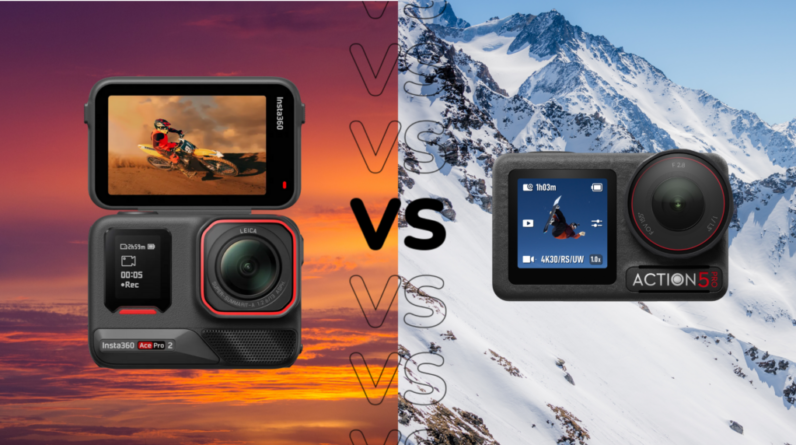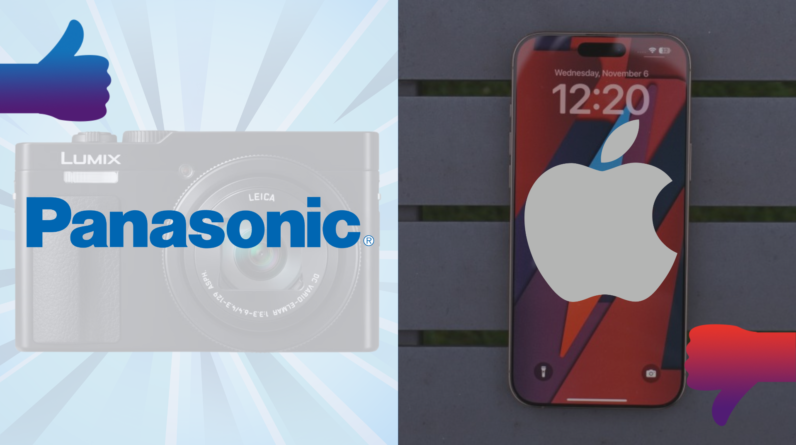
Insta360 and DJI both updated their flagship action camera lines this autumn. For Insta360, that came in the form of October’s Ace Pro 2 launch, while DJI showcased the Osmo Action 5 Pro in September.
Both are popular choices in the action camera field, but how do they compare when it comes to their design, features and image quality? We’ve tested both cameras and set them head-to-head in this guide.
Price
The Insta360 Ace Pro 2 was unveiled on October 22 2024. Prices start at $399.99/£389.99 for the Standard Bundle. This includes the camera, a battery, wind guard, standard mount, mic cap and USB-C cable.
The DJI Osmo Action 5 Pro launched one month earlier on September 19 2024. The Standard Combo costs $349/£329 and includes the camera, an Osmo Action Extreme Battery Plus, a horizontal-vertical protective frame, quick-release adapter mount, curved adhesive base, locking screw, rubber lens protector, glass lens cover, anti-slip pad and USB-C cable.
Design and handling
- The DJI Osmo Action 5 Pro is more waterproof
- The Insta360 Ace Pro 2 has a new wind guard
- The Insta360 Ace Pro 2 features a flip-up touchscreen
Like all action cameras, the Insta360 Ace Pro 2 and DJI Osmo Action 5 Pro are small, lightweight and rugged.
The Osmo Action 5 Pro is more water-resistant than the Ace Pro 2 as the camera can be plunged up to 20m into water. The Ace Pro 2, on the other hand, can dive up to depths of 12m, though both of these numbers can be increased with the addition of a waterproof case.
The Insta360 Ace Pro 2 has a new wind guard that stays on the camera whenever it’s out of the water and helps reduce audio interference on blustery days.


Both cameras are controlled via a combination of physical buttons and a touchscreen. The Osmo Action 5 Pro takes advantage of two touchscreens – one on the front and one on the rear. The Ace Pro 2 takes a more unique approach with a single touchscreen that flips up to be viewed in either direction.
The main benefit of the Ace Pro 2’s flip-up display is that its larger than that of its rivals. However, it does take a bit longer to switch between front and rear views than the Action 5 Pro’s dual fixed displays.
Winner: DJI Osmo Action 5
Performance and features
- Both cameras offer electronic image stabilisation and horizon levelling
- Both support a range of shooting modes
- There are additional features available through their respective apps
Both action cameras feature electronic image stabilisation, with the Ace Pro 2 offering Standard and High levels of Insta360’s FlowState stabilisation and the Osmo Action 5 including DJI’s Rocksteady 3.0 EIS at two levels. We found both to be effective, with the higher levels of stabilisation producing a more dramatic crop.
There’s also horizon levelling available on both cameras. The Ace Pro 2 features 45- and 360-degree horizon levelling, while the Osmo Action 5 Pro includes Horizon Balancing for tilts of up to 45 degrees and HorizonSteady to keep the horizon level at up to 360 degrees.


Otherwise, the Ace Pro 2 offers a range of shooting modes and features, including PureVideo for low-light settings, timeshift, timelapse, starlapse and an AI selfie stick eraser. The Osmo Action 5 Pro, meanwhile, includes SuperNight, slow motion, timelapse and hyperlapse modes, along with a new subject tracking mode that automatically frames human subjects for 9:16, TikTok-style video.
Other features on the Ace Pro 2 include voice and gesture controls and support for Bluetooth microphones. The action camera is also compatible with with Insta360 mobile app for remote control, file transfer, editing and sharing footage. The Osmo Action 5 also supports voice controls, but no gesture controls. It includes Bluetooth support, allowing you to connect DJI’s fantastic Mic 2 clip-on microphones, and there are remote shooting, editing, sharing and live streaming features available through the DJI Mimo app.
Winner: Draw
Video and photo quality
- The Ace Pro 2 has a separate AI chip this time
- The Ace Pro 2 can record 8K/30fps video, though both cameras function best in 4K
- Both cameras are okay in low-light but work best in daylight
The Insta360 Ace Pro 2 takes advantage of two image chips this year, one for denoising and other processing functions and the other for AI features. These chips sit alongside a 1/1.3-inch sensor that offers a dynamic range of up to 13.5 stops.
The headline feature on the Ace Pro 2 is undoubtedly 8K/30fps video. However, while 8K is nice to look at, it comes at the expense of higher frame rates, image stabilisation, a wider field of view, Active HDR and the I-log colour profile. Our reviewer preferred opting for the 4K mode which offered all of the above and is more widely supported than 8K.


The DJI Osmo Action 5 Pro also features a 1.1.3-inch sensor and offers the same 13.5 stops of dynamic range. The highest resolution here is 4K/120fps which we think is fine – after all, few people have the means to make the most of 8K or even 5.3K footage. Both cameras work best in good lighting conditions, with noise and artefacts sneaking into low-light footage due to the small sensors.
Winner: Insta360 Ace Pro 2
Battery life
- The Osmo Action 5 Pro has a bigger battery and longer battery life
- The Ace Pro 2 supports reverse charging
- Both action cams can be used as webcams
Finally, when it comes to battery life, the Ace Pro 2 packs an upgraded 1800 mAh battery. The camera also includes a new Endurance Mode that enables 4K/30fps recordings of up to 140 minutes before the battery runs out. With the regular operating mode and the frame rate increased to 60fps, this number drops to 69 minutes.
The battery also supports reverse charging, allowing it to be used to top up a smartphone or similar-sized device via USB-C.


The Osmo Action 5 Pro, meanwhile, features a slightly larger 1950 mAh battery. We found that the camera could record 120 minutes of 4K/60p video – almost twice as long as the Ace Pro 2 at the same resolution.
There’s no reverse charging support here, but both action cameras can be used as webcams when plugged into a computer via their USB-C ports.
Winner: DJI Osmo Action 5 Pro
Verdict
The Insta360 Ace Pro 2 and DJI Osmo Action 5 Pro are two leading action cameras, but which comes out on top?
The Ace Pro 2 benefits from 8K video support, better built-in audio, a larger touchscreen, reverse charging and a dedicated AI chip. The Osmo Action 5 Pro, meanwhile, offers a higher waterproof rating, a quicker-to-access front display, live streaming support and a significantly longer battery life.
Buy Insta360 Ace Pro 2 if…
You want to capture 8K video.
Buy the DJI Osmo Action 5 Pro if…
You want the most rugged camera with up to 20m of protection underwater.






